How Artifact became Valve's biggest failure
Magic silenced.
Artifact is a mess. 101 players are in game at the time of writing, with the 24 hour peak being only marginally better at 124. Valve hasn't said anything about the game since 29th March, when the company announced the team will "be heads-down focusing on addressing these larger issues instead of shipping updates". The most action Artifact has seen on Twitch in recent months was when people decided to stream full length movies and porn in the game's section. Artifact, at least for now, is a dead game, and arguably Valve's most spectacular failure to date.
"It was a couple of weeks before the Artifact launch, and I was like, they can't really launch it like this can they?" Sean "Swim" Huguenard tells Eurogamer.
By this point Swim had been in the Artifact closed beta for almost a year, and had submitted "several pages of pretty lengthy feedback" to the development team. He made a name for himself in the world of Gwent, having been one of the top deck creators, had consulted on other games, and planned to go into Artifact when it launched as both a content creator and pro player, aiming to make it to the $1m tournament Valve had planned for early 2019, even signing with esports organisation Evil Geniuses. So he certainly knew more than most when it came to card games. But it seemed the feedback from him, and other top card game players, was being ignored during the beta.
"It's a test build, so you don't really expect the game to be perfect, but we all saw something, you know, all the card game pros, basically looked at it and were like, these are really great fundamentals, there's so much potential here," says Swim. "And then it just felt like there wasn't really a lot of changes during this period. A lot of us engaged in conversations with the developers, which didn't really end up resulting in any changes, which was very disappointing."
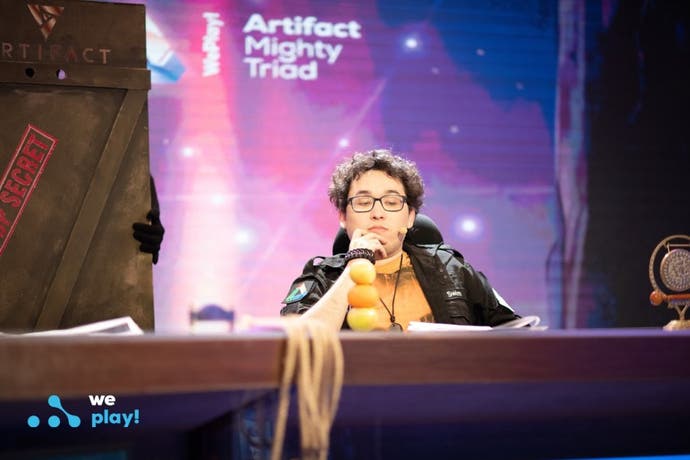
The lack of significant changes during the closed beta is something multiple participants have revealed. There were some here and there, with changes such as Drow Ranger's rarity being boosted and others reduced, and the costs of Cheating Death and Golden Ticket being changed, but for the most part the core game we played at launch was the same as it had been through most of the closed beta, which kicked off about a year before launch.
"That is largely true, there were not a lot of balance changes, there were some but not a lot, mainly because it was very balanced," says Skaff Elias, a veteran Magic: The Gathering designer and member of Three Donkeys, who was officially a consultant on Artifact but acted as one of the lead designers. "We didn't want to push the community to preconceived notions because then that kind of spoils the value of the test. So, you kind of let them play around with stuff and then they'll say 'Oh, this thing here is too good.' And then you kind of know, on the back-end, that it's not, because you've been through that before, you've played that. So that would continuously happen throughout the beta. Some people would say they don't like this, and other people would say they do like that, you know, there was a lot of mixed results. In the end, the balance from our perspective was very much in-line with what we would expect from a trading card game."
Balancing things in the beta wasn't the only time the dev team knew, or at least thought, they were right about something. They compiled a ton of data about the game and how people were playing it, which they claim proved a number of thoughts the community had about the final release were in fact completely wrong. Some of the biggest complaints about Artifact from the public were around the RNG in the game and how that can determine who wins and loses in some situations, especially with the arrows that decide what unit your card will attack. Better players obviously rose to the top, but players claimed at times games could be decided entirely on RNG.
"A lot of the issues the players have, that there's been complaints about, there's demonstrable information to the contrary," says Richard Garfield, creator of Magic: The Gathering and consultant come lead designer for Artifact. "So, for example, when players complain about the luck in the game, there is demonstrably more skill in this game than in any other digital trading card game as measured by the Elo rating that players achieve. So there's this complaint but there's this black and white contradiction to it. For people complaining about the price, there's a complaint about how much money it costs, but there's a black and white contradiction in the sense that if you want to be competitive in a game like say Hearthstone or Magic, you have to pay far more."
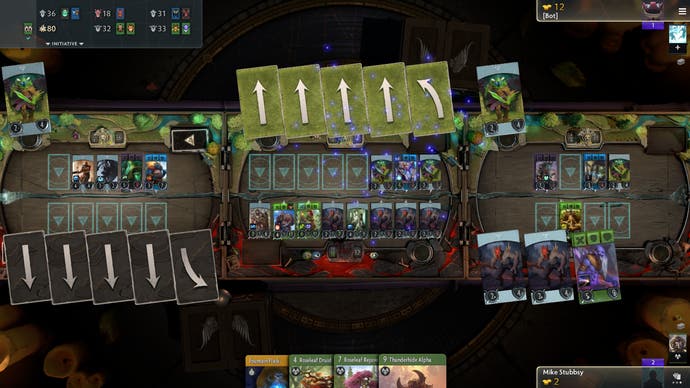
Despite occasional whispers on Reddit and top level players arguing the RNG wasn't that big of a factor, there was never categorical proof this was the case, despite the data existing to prove it, and a lot of the players soon accepted luck was always going to be a big factor in Artifact and there wasn't much they could do about it. This surely turned off a lot of players, yet if that data had just been released it may have changed community opinion.
"Valve like their players to drive their marketing," continues Garfield. "I think that at some point, you have to take control of that yourself. They have some very positive messages there and very positive things in their game design and they're being sort of misrepresented by a lot of the player community."
There were of course other issues to contend with, and some that would have become apparent if Artifact had survived longer. Swim mentions the original set of cards released in Artifact perhaps wasn't the best, and could have caused issues down the road. He also says with more card releases, playing single colour decks would probably become the norm, effectively removing one of the more challenging features of Artifact's deck building. Add in the fact the pro scene never really got a chance to flourish despite some early tournaments with decent viewership, no progression system at launch and also no mobile version, and you start to see more reasons to stop playing cropping up.
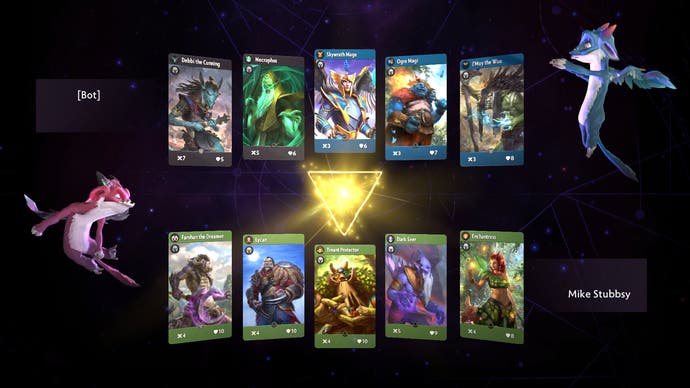
However, it seems the biggest issue for Artifact was the pricing structure. First off you had to drop £15.99 to just buy the game, which would give you two starter decks and 10 bonus packs of cards. If you then wanted to get more cards, which would have been necessary if you wanted to build a top level deck unless you got incredibly lucky, you would either have to buy more packs at £1.49, win them in the game modes that require a ticket, which cost £3.75 for a pack of five, to enter, or simply buy the cards from the Steam Marketplace.
But the rarity of the strongest cards such as Axe, "a card you needed in 80 per cent of competitive decks," according to Swim, meant prices shot up. Within two days of launch a single Axe already cost more than the game itself. It felt like you had to put down a lot of money if you wanted to play with a competitive deck in the most competitive modes in the early days.
"Obviously, when the customer's complaining about it, there's something wrong," says Elias. "What's wrong might be your marketing efforts, or your explanation, or you're not providing enough value, or you're charging too much. There's a whole myriad of things that could be wrong but it's pretty clear that something was wrong there on that particular disconnect. I think a free-to-play game would have probably passed some of the initial bars better.
"For the amount we were charging them, we either had to do one of two things. We either had to lower the price or return more value from the customer's perspective. I mean, it seems obvious but it had to be one of those. And ways of returning value, there's a lot of different games doing it in a lot of different ways. I mean just this social presence, the social media part of it, people find value in that. That's not appropriate for this particular game but it's just, like I said, there's a lot of ways to return value to the customer."
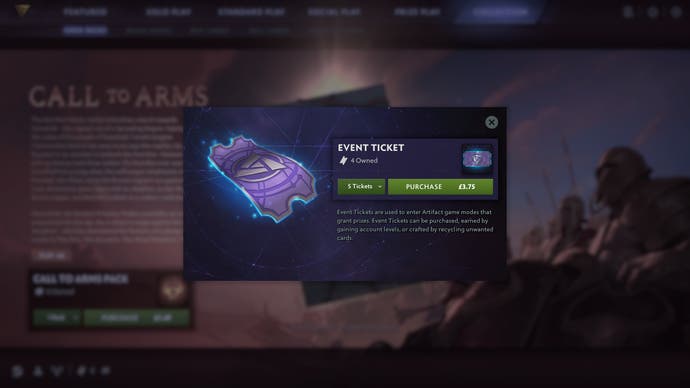
Engaging with the community certainly would have helped Artifact in the very early days, (and it seems Valve has learnt that lesson as they are now active within the Dota Underlords community, so at least something positive seems to have come from Artifact's demise,) but it's unlikely that would have saved the game. The pricing structure was simply too steep for some people, and even for those who did invest some money it left a bad taste in their mouth.
"I mean, it's a different model for a card game, I certainly don't like that it's not free, but if they made the rest of the things cheap enough, then it might be okay," says Swim. "The fact you had to buy tickets to play the more competitive modes, on top of the other costs, is just super ludicrous. The ticket system was absolutely just really ridiculous. I don't know how that slipped by. I do think a lot of people kind of blame the designers, when it seems to me in the weeks leading up to launch there was someone on the inside, someone higher up, basically looked at Artifact and said, 'this needs to make more money.' There must have been some decision internally that must have sort of thrown everyone under the bus, so to speak."
We will most likely never know what the conversations at Valve, who did not respond to our interview request, around the monetisation were like, but it is pretty clear monetisation was one of the biggest reasons Artifact did not work. Elias mentioned that turning it free-to-play would not be as simple as just removing the price, but at this point it seems if Artifact is ever going to have another chance, going free-to-play is perhaps the only option.
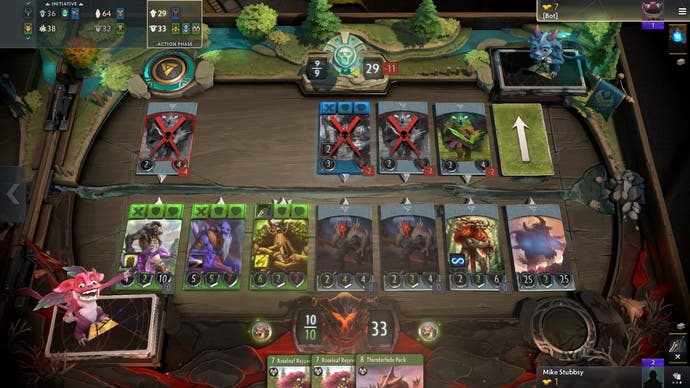
What we do know is neither Garfield nor Elias will be working on turning Artifact around. As reported some months ago, their contracts with Valve expired shortly after launch and they have not been actively working on the game since. Elias did say this was no big deal and happened because "the job was completed," but both he and Garfield said if they had appropriate things to be doing they would be up for working on Artifact again.
Unfortunately, right now the work that Artifact needs is going to take a long time and doesn't really require designers such as Garfield and Elias, and that's if the game is even being worked on. Many in the community believe Artifact might just be dead at this point, doomed to forever be the big failure from Valve.
"Personally, I'm interested in designing new games or expanding old games," says Garfield. "I don't want to be involved in damage control and figuring out how to find an audience for this game. I think the underlying game is excellent and original. It gives the player something new. So in that sense, since there's something there to offer the player, I think it's possible to save it. Since Valve is a smart company with lots of smart people working there, I think that it's possible they can do that.
"Will they? It's hard to say."

